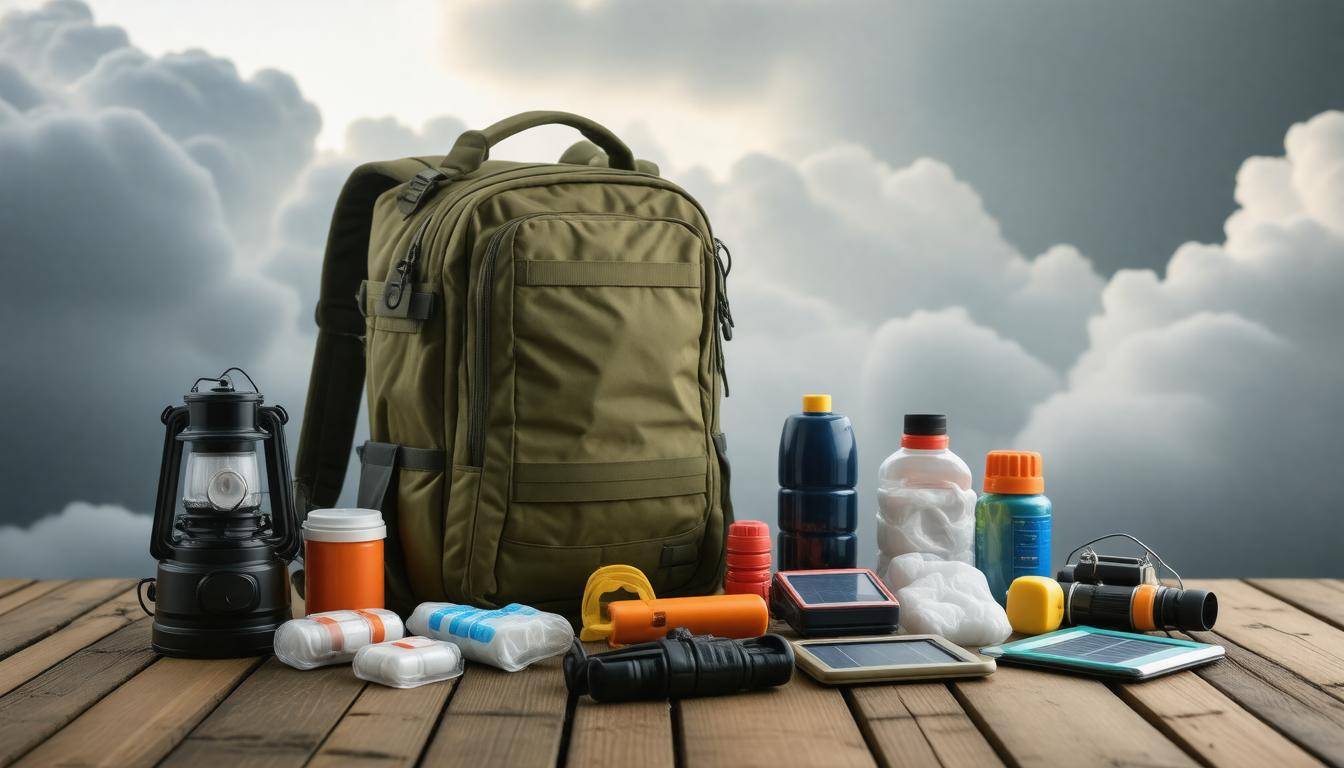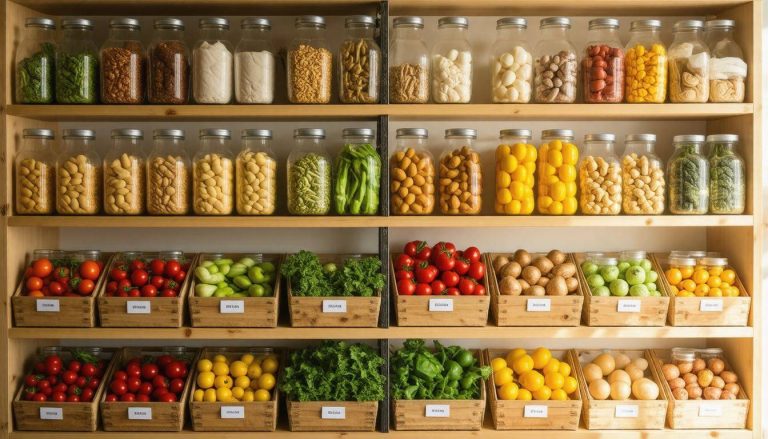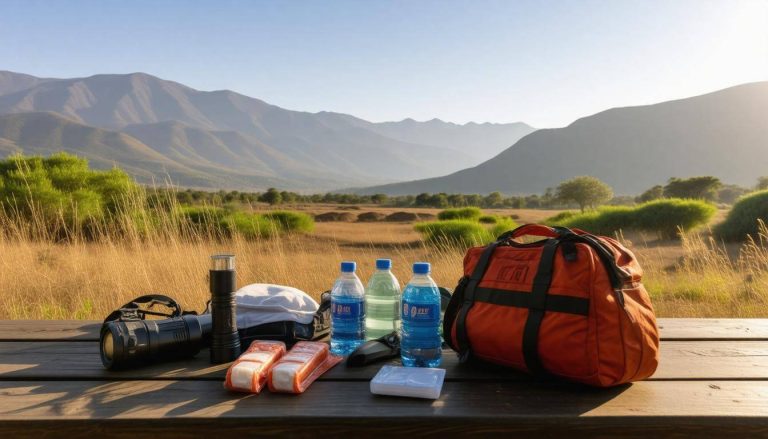In Kenya, the threat of extreme weather is all too real. Droughts can devastate crops and water supplies, while sudden flash floods can sweep away homes and livelihoods in an instant. Whether you live in a region prone to dry spells or are vulnerable to torrential rains, preparing for these unpredictable conditions is not just smart—it’s essential. This article will guide you through creating a Kenya Drought and Flash Flood Preparation Kit, ensuring that you and your loved ones are equipped to face whatever nature throws at you. From gathering crucial supplies to understanding seasonal weather patterns, we’ll cover everything you need to know to stay safe and resilient during emergencies. So let’s dive into the steps necessary to take control of your preparedness today!
A Kenya Drought and Flash Flood Preparation Kit should include essential items such as emergency food supplies, water purification systems, first aid kits, portable water containers, durable clothing suited for varying weather conditions, and tools for managing drainage such as shovels or aeration equipment. Additionally, incorporating native plants in your landscaping can help manage water effectively during floods while providing drought resistance.

Assembling Your Kenya Drought & Flash Flood Kit
When it comes to assembling your survival kit, selecting the right container is crucial. Opt for a waterproof, durable container that can withstand both moisture and impact. A high-quality plastic storage bin with a secure lid is a great choice, keeping contents dry and protected from flooding. Alternatively, you might prefer a robust backpack with multiple compartments for easy organization and transport. Think of it as your safety net—having everything in one location will save you time when an emergency strikes.
Once you’ve secured your container, it’s essential to fill it with the right tools that can aid you in various emergencies.
Step II – Include Basic Tools
In this digital age, we often forget about the simplest yet most effective tools. A multi-purpose tool like a Swiss Army knife serves as an all-in-one solution for numerous tasks: from food preparation to minor repairs, you’ll find it invaluable. Additionally, don’t overlook the importance of light—include at least one flashlight with extra batteries to ensure visibility during unexpected power outages. You should also add duct tape; it can be used for nearly anything—from repairing items to creating makeshift solutions. Last but not least, include a whistle for signaling if you need to attract attention during emergencies; its sound travels far and could be your best friend when every second counts.
Having gathered your tools, let’s focus on ensuring you have access to vital information in case of an emergency.
Step III – Pack Important Documents
In chaotic situations, having important documents readily available can make all the difference. Gather copies of essential documents such as identification cards—including national IDs or passports—and medical records that outline any pre-existing conditions or allergies. It’s wise to keep these materials sealed in waterproof bags so they remain intact during adverse weather conditions. Additionally, create a list of your emergency contacts and consider adding local authorities and nearby loved ones who can assist when needed. This little bit of organization will give you peace of mind—you’ll be prepared on several fronts.
With critical documents secured, let’s turn our attention to health and safety supplies that can sustain you through trying times.
Step IV – Health and First Aid Supplies
Health should always be a priority in any emergency kit. Assemble a comprehensive first aid kit that contains fundamental supplies: bandages of various sizes for cuts and scrapes, antiseptic wipes for cleaning wounds, and pain relievers like ibuprofen or paracetamol for any discomfort. Don’t forget medications specific to chronic conditions; even if you’re managing them effectively now, their absence could lead to serious complications later on. Including a manual on basic first aid procedures is another smart move—it’s empowering to know how to treat common injuries or ailments in high-stress situations.
With health essentials packed away, the next step involves thinking strategically about what sustenance you’ll need in difficult circumstances.
Essential Water and Food Supplies
Water stands out as the most indispensable resource in any survival kit. Its critical nature cannot be overstated, especially in regions like Kenya, where drought and flooding can disrupt access to safe drinking water. It’s recommended to store at least one gallon of water per person per day for a minimum of three days. However, the CDC’s advice leans towards storing enough for two weeks—because when emergencies hit, it pays to be prepared.
That means if you have a family of four, you should ideally have 56 gallons of water on hand. While this may sound daunting, consider using stackable containers or large drums that can easily fit into storage spaces.
Alongside your stored water, it’s prudent to include water purification tablets and filters. These tools are essential for treating water from uncertain sources, such as rainwater collection or streams during floods. For instance, the popular LifeStraw is a handy gadget that can filter out bacteria and parasites; just one straw can purify up to 1,000 liters of contaminated water. This not only reduces waste from disposable plastic bottles but also encourages sustainable practices during challenging times.
Non-Perishable Food Items
When it comes to food items for your emergency kit, focus on non-perishable options that offer nutritional value and cater to various dietary needs. An effective approach is to prioritize foods that are not only long-lasting but also provide sufficient calories to sustain energy levels during stressful situations.
Here are some staples you should consider:
-
Canned goods: Items such as beans, vegetables, and fruits are nutrient-rich and user-friendly.
-
Dried cereals and granola bars: Easy to pack and quick to eat, these will keep spirits up with familiar flavors.
-
Dehydrated fruits and vegetables: Lightweight yet packed with nutrients, these can add variety without taking much space.
-
Ready-to-eat meals (MREs): A go-to choice for convenience; they require no preparation and cater to varied tastes.
-
Peanut butter and nuts: Excellent sources of protein, these not only provide energy but also have long shelf lives.
Ensuring adequate food supplies means being prepared for longer periods when local resources might be scarce due to extreme weather events. Items like granola bars or dried fruits can lift morale while sustaining physical strength.
With sustenance secured, preparing for harsh conditions requires appropriate clothing and equipment tailored for the unpredictable weather patterns present in the region.
Protective Gear for Extreme Weather
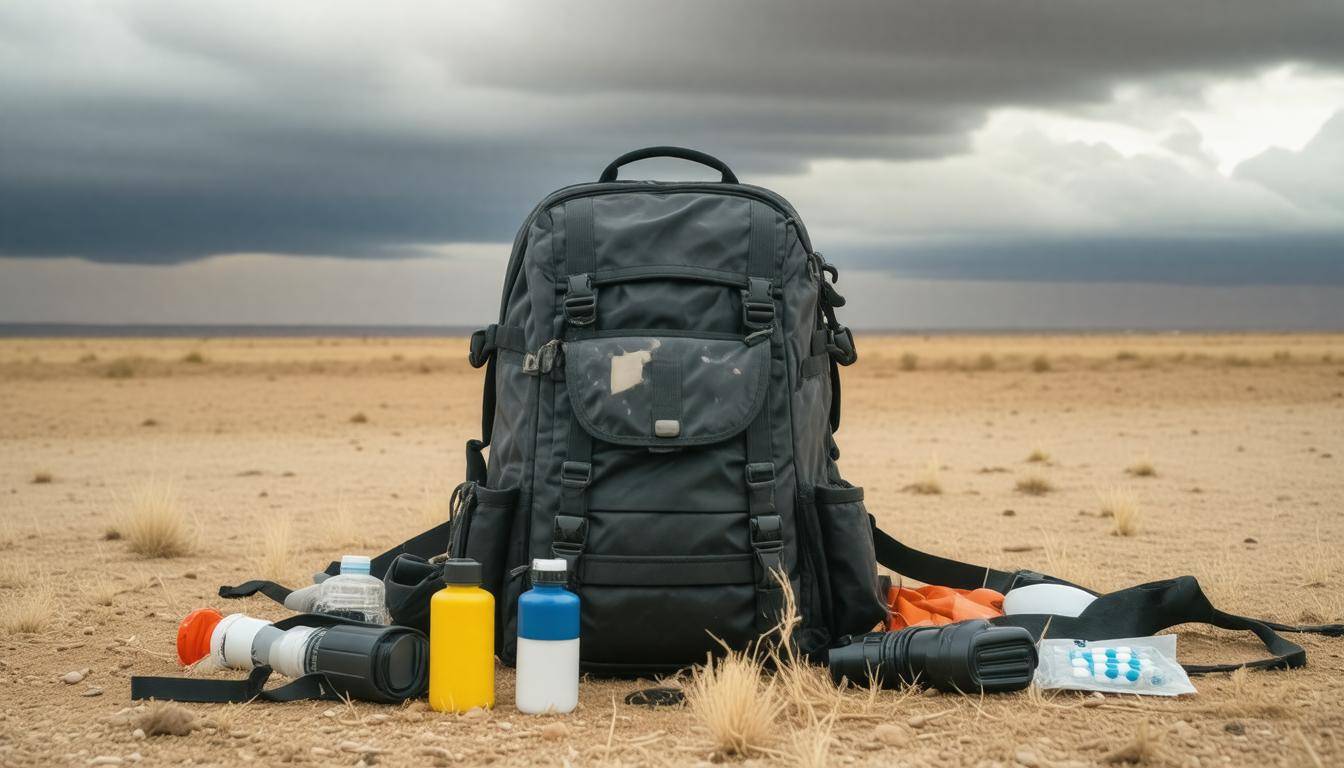
Preparing for both the intense heat of a drought and sudden downpours is essential for survival. Having the right clothing and equipment can make all the difference in how effectively you navigate these unpredictable conditions. When it comes to protecting yourself from the sun, lightweight, long-sleeved shirts are a must. They shield your skin from harmful UV rays while keeping you cool. Pair these with wide-brimmed hats and UV-protective sunglasses to ensure you’re thoroughly shielded from sunburn and heatstroke. These items not only protect you but also allow your skin to breathe, preventing overheating—a crucial factor when temperatures soar.
Extreme Heat Protection
An important addition to your summer gear could be a portable, battery-operated fan. Imagine being out on a scorching day when relief feels far away; having a little fan can provide instant respite. It’s compact enough to carry with you wherever you go. Remember to look for lightweight fabrics that wick moisture away from your body; they keep you cooler and dry much longer than conventional materials. Clothing is an investment in your health during harsh weather conditions, so take time to choose wisely.
But as predictable as the sun may be in some areas, rain can strike without warning, creating its own set of challenges.
Rain and Flood Protection
To prepare for unexpected rain or flash floods, consider investing in waterproof raincoats crafted from breathable materials that can handle heavy downpours without making you feel suffocated inside. Sturdy waterproof boots are also vital—they keep your feet dry and provide necessary traction on slippery surfaces. Adding a durable umbrella to your kit provides another layer of protection against sudden rain collapses. However, useful as it is, an umbrella might not always suffice when extreme winds are at play, so remembering practical alternatives is key.
You might even want to consider packing heavy-duty garbage bags; they serve wonderfully as makeshift ponchos or gear protectors when storms loom large over you unexpectedly. These bags can be lifesavers in tight situations. Furthermore, don’t underestimate the value of thermal blankets—they’re compact yet remarkably effective at retaining body heat when temperatures plummet after a rainstorm. It’s astonishing how something so seemingly basic can hold such immense potential for warmth and comfort.
Each piece of gear enhances your immediate safety and contributes to greater preparedness strategies during climate fluctuations we increasingly face today. This proactive approach enables you to manage whatever nature throws your way more effectively and confidently.
Long-Term Storage Solutions
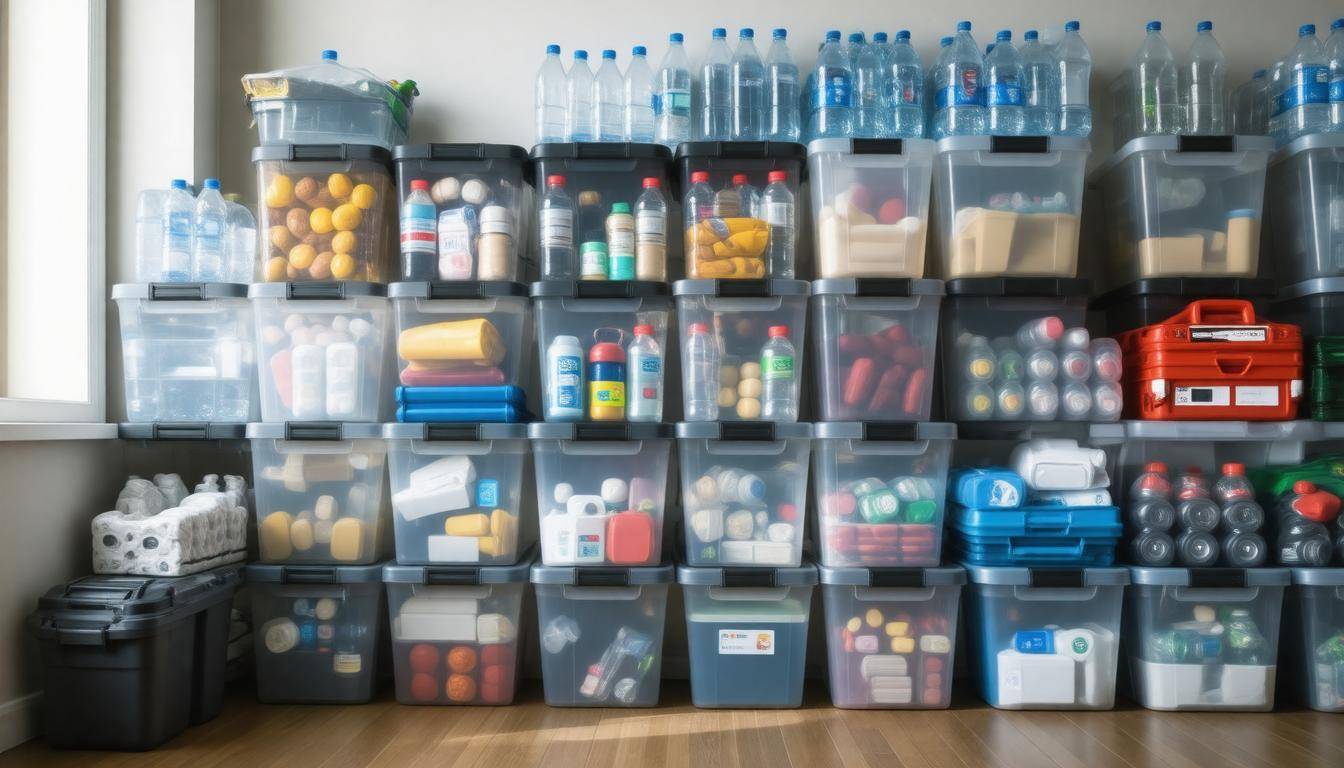
Effective storage of your emergency supplies isn’t just about organizing them neatly; it’s about ensuring that everything remains ready for use when you need it most. The foundation of a successful long-term storage plan involves several key steps that will protect your food, water, and important documents from damage over time.
Step I – Rotate Supplies
First and foremost, rotation is vital. Regularly checking expiration dates on your food, water, and medications may seem tedious, but it pays off. Aim to rotate supplies every six months—this means removing older items and replacing them with fresh ones. It’s surprising how quickly canned goods or medications can pass their prime. Remember, expired items can spoil or lose effectiveness, limiting your options in an emergency.
Step II – Climate Control
Next on your list should be climate control, as where you store your supplies matters immensely. Ideally, you want a cool, dry place away from direct sunlight and humidity. Just think of it like this: if your mom used to tell you not to leave chocolate in a hot car, the same principle applies here! Extreme temperatures can warp packaging, ruin flavors, or even compromise the integrity of medications and batteries.
A stable environment protects your resources and gives you peace of mind when storms roll in unexpectedly.
Step III – Vacuum Sealing
One effective method for prolonging the shelf life of your emergency essentials is vacuum sealing. Food packs sealed in this manner are kept away from air and moisture, which are two primary culprits in spoilage. You can easily vacuum-seal grains, spices, or even individual meal portions for later use.
Moreover, consider doing the same for important documents or items like first-aid supplies; shielding them from moisture and pest invasion ensures they’re intact when you need them most.
There’s something incredibly reassuring about knowing that you’ve taken these steps to secure your essentials. By regularly rotating supplies, maintaining climate control, and utilizing vacuum sealing techniques, you set yourself up for success during uncertain times ahead in Kenya’s dynamic weather landscape.
As we turn our attention to how seasonal variations impact preparedness strategies, understanding expected patterns becomes essential for effective planning.
Understanding Seasonal Weather Patterns
Kenya’s dynamic climate is heavily influenced by a variety of seasonal weather patterns, primarily characterized by wet and dry seasons. Knowing these cycles is crucial for safety measures related to potential droughts or floods.
The wet season, typically from March to May and again from October to December, brings heavy rainfall that influences water supply and agricultural productivity. In contrast, the dry season, which generally occurs from June to September, leads to reduced water availability and increases the risk of drought conditions.
Interestingly, the presence of meteorological phenomena like El Niño and La Niña can significantly alter these expected patterns. For instance, recent La Niña conditions indicate shifts that could lead to less severe rainfall during wet seasons—resulting in an increased likelihood of drought when rain is expected. This situation places many communities at risk.
With this in mind, accurate weather forecasting becomes invaluable for proactive measures.
Predicting Extremes
Fortunately, organizations like the Kenyan Meteorological Department provide regular updates and forecasts to help communities prepare for potential extremes. Utilizing these resources keeps you informed about sudden weather changes that could impact your planning.
The “Early Warning for All” initiative exemplifies efforts to improve prediction systems. This program aims to equip families with timely information, allowing them to respond swiftly—whether it be stocking up on necessities before a predicted flood or conserving water ahead of a forecasted drought.
By actively following these updates, you not only keep yourself aware but can also encourage community members to do the same. A well-informed group stands better prepared against natural disasters; it’s about creating a resilience plan collectively.
As you consider preparation strategies, an essential aspect includes having a cohesive family emergency plan that responds effectively to these unpredictable weather events.
Creating a Family Emergency Plan
Ensuring all family members are aware of and prepared for potential emergencies significantly increases survival chances. A solid emergency plan serves as a roadmap, guiding each individual through what can often be chaotic and stressful circumstances.
Therefore, the first step is establishing effective communication within the family.
Step I – Communication Plan
Start by creating a communication strategy that includes a list of essential contacts, such as local emergency services and nearby relatives or friends who may assist during an evacuation. Select designated meeting points, preferably outside your home and in a safe area where everyone can gather without confusion.
As you assign roles to each family member, ensure they not only understand their responsibilities but also feel comfortable fulfilling them. For instance, one person might act as the communicator, another as the documentarian capturing events for safety purposes, and someone else to take charge of first-aid supplies. This team effort empowers your family while fostering a sense of security.
Step II – Evacuation Routes
Next, it is crucial to identify multiple evacuation routes from your home and throughout your neighborhood. In moments of crisis, taking familiar paths can lead to faster, safer exits. A helpful approach is to map out these routes on paper and discuss them during family meetings.
Conduct regular drills to practice these evacuations, simulating various scenarios such as wildfires or floods. Testing these routes helps ensure everyone is familiar with them when urgency strikes. When I practiced this with my own family, we discovered alternative paths we hadn’t previously considered, reinforcing the importance of being adaptable.
Step III – Practice and Review
Finally, regularly reviewing and practicing your emergency plan is essential. Make it a highlight of family gatherings or incorporate it into game nights for younger children to enhance engagement.
As situations evolve, don’t forget to revisit your plan and update it when necessary; new members might join your household or changes in local emergency protocols should be reflected in your strategy. Encouraging open discussions about the plan ensures that children grasp what they need to do in different situations, alleviating anxiety and boosting their confidence.
By actively engaging with these elements—communication strategies, evacuation routes, and regular practice—you lay the groundwork for a resilient family ready to tackle any emergency effectively. This preparation paves the way for exploring vital resources that can contribute to safety in unpredictable situations.
Safety and Survival Tips
Simple strategies can dramatically improve your chances of weathering difficult conditions during both droughts and flash floods. The key is to be prepared and adapt to the environment around you.
Stay Hydrated in Drought
It’s crucial to prioritize hydration during drought conditions. While rationing water appropriately is important, always remember that drinking enough water should be your top priority. Wear light clothing to help your body regulate its temperature, and avoid strenuous activity—especially during peak heat hours—when the sun is at its most intense. By conserving energy, you will reduce your overall need for water, making the limited supply last longer.
Avoid Floodwaters
When it comes to flash floods, the best advice is simple: never attempt to walk or drive through floodwaters. Just six inches of moving water is enough to knock over an adult, and you never know how deep it really is or how strong the current might be. The California National Weather Service echoes this concern: most flood-related fatalities occur because people try to navigate through these treacherous waters. It’s critical to respect and understand the power of water; sometimes, waiting it out is far safer than attempting to cross.
Safe Shelter
Location is everything in emergencies. During floods, seek higher ground immediately, as this can be a lifesaver when waters begin to rise unexpectedly. Conversely, find shelter from direct sunlight during severe drought conditions whenever possible, as prolonged exposure can lead to heat exhaustion or worse. Knowing where emergency shelters are located in your area ahead of time offers strategical peace of mind as well.
As physical safety is paramount, staying informed also plays a vital role in maintaining preparedness during natural disasters. This proactive approach can make all the difference when facing unpredictable weather events.
Staying Informed and Prepared
Information serves as a guiding light during times of crisis, allowing communities to anticipate problems before they escalate. One of the key strategies for maintaining safety and preparedness is to leverage reliable information sources. For instance, constantly following updates from respected organizations such as the Kenya Meteorological Department can provide crucial insights into impending weather changes. These updates are not just about forecasts; they also deliver advisories that can inform you about necessary precautions. Additionally, local news outlets can serve as your on-the-ground resource, offering real-time interpretations of weather patterns and community conditions.
To enhance your response to changing scenarios, consider utilizing mobile apps designed specifically for weather alerts. These tools can deliver critical notifications regarding sudden weather shifts, ensuring that you stay ahead of any impending emergencies. In a world where conditions can change in an instant—think dark clouds rolling in unexpectedly—it’s vital to have immediate access to information at your fingertips.
Join Community Preparedness Programs
This leads us nicely into another beneficial aspect of staying informed: engaging with community preparedness programs. Many localities host workshops and meetings aimed at educating residents about emergency protocols relevant to their area. By participating in these initiatives, you gain valuable insights into how to respond during crises while connecting with others who share similar concerns and experiences. There’s something empowering about learning practical survival techniques alongside neighbors who may also need support during an emergency.
Remember: Active participation in community programs fosters a sense of solidarity within neighborhoods, ensuring that no one faces disasters alone.
| Resource | Description |
|---|---|
| Kenya Meteorological | Provides critical weather updates and forecasts. |
| Early Warning for All | Initiative that offers timely disaster alerts to locals. |
| Local News Outlets | Deliver real-time updates regarding current conditions and safety advice. |
| Community Workshops | Host valuable training sessions on practical survival techniques and networking opportunities. |
By implementing these strategies—staying updated through reliable information sources and actively participating in community preparedness—you arm yourself with the knowledge needed to navigate extreme weather conditions effectively. This proactive approach not only safeguards your well-being but also enhances the resilience of your entire community amidst unpredictable challenges.
In an environment where uncertainty looms large, being prepared can mean the difference between chaos and control. Equip yourself with the right information and resources to face any challenge head-on.

